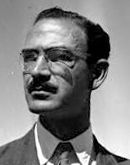

Manuel Valls
*3. 3. 1912 – Barcelona, Spain
†22. 8. 2000 – Barcelona, Spain
Biography
Manuel Valls i Vergés was a Catalan architect who was part of the "first post-war generation" of Spanish architects. His father was a doctor, and Manuel also wanted to become one, but in 1929, as a first-year medical student, he visited the Barcelona International Exhibition and saw the pavilion by Mies van der Rohe: "When he saw all those new materials and beautiful things that could be made from them,” he decided to become an architect. In 1940, he completed his architecture studies, and a year later, he established a joint studio with José Antonio Coderch. This partnership lasted until the 1960s. His initial architectural phase was characterized mainly by the construction of small houses on the Catalan coast. Simple shapes and white walls reached their peak expression in the Ugalde house built in 1951 near Barcelona. This extremely simple building is one of the most admired works of Spanish architecture in the past half century. In 1960, he won the FAD award for architecture and began teaching at ETSAB in the Barcelona School. In 1982, he received the COAC award (Catalan Society of Architects). He died in 2000 and is buried in the coastal town of Arenys de Mar, where he served as the municipal architect for 23 years.
Manuel Valls i Vergés was a Catalan architect who was part of the "first post-war generation" of Spanish architects. His father was a doctor, and Manuel also wanted to become one, but in 1929, as a first-year medical student, he visited the Barcelona International Exhibition and saw the pavilion by Mies van der Rohe: "When he saw all those new materials and beautiful things that could be made from them,” he decided to become an architect. In 1940, he completed his architecture studies, and a year later, he established a joint studio with José Antonio Coderch. This partnership lasted until the 1960s. His initial architectural phase was characterized mainly by the construction of small houses on the Catalan coast. Simple shapes and white walls reached their peak expression in the Ugalde house built in 1951 near Barcelona. This extremely simple building is one of the most admired works of Spanish architecture in the past half century. In 1960, he won the FAD award for architecture and began teaching at ETSAB in the Barcelona School. In 1982, he received the COAC award (Catalan Society of Architects). He died in 2000 and is buried in the coastal town of Arenys de Mar, where he served as the municipal architect for 23 years.
The English translation is powered by AI tool. Switch to Czech to view the original text source.











